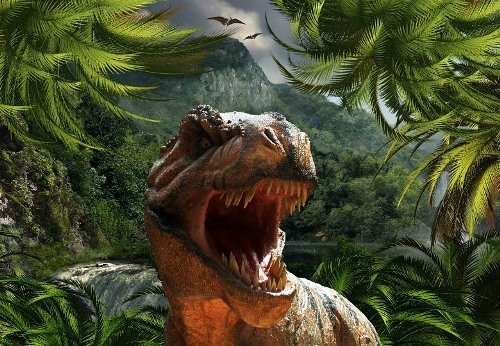|
Parque Cretácico Sucre Dinosaur Park The Cal Orcko Dinosaur Park, in Sucre Bolivia is also known as Parque Cretácico or Cretaceous Park. It sits atop a hill that overlooks a large portion of the city and is located next to a rock quarry that belongs to the Fancesa cement factory, next door. In fact, it is thought that because of this cement factory, which owns the property, the largest set of dinosaur footprints on Earth was found. Due to the vibrations causes by the quarry, in 1998 a large portion of earth slid off a cliff exposing over 5055 tracks belonging to at least 8-15 species of terapods including sauropods, titanosaurs, terapods, ornithopods, hadrosaurs, ceratops, and ankylosaurus.
The Parque Cretácico dinosaur park is located in the Cal Orcko zone of the city. It was built directly across from the cliff where the dinosaur tracks can be seen. The main features of the park are numerous life-sized, scientifically researched replicas of dinosaurs. Hidden speakers project the sounds they may have made as you walk through the park.
The dinosaur park also has a video viewing room where you can see documentaries about paleontology and dinosaurs in both English and Spanish, a small indoor museum with a T-Rex skeleton and other artifacts, a souvenir and gift shop, a café and a viewing area completely with telescopes from which to observe the dinosaur tracks. From atop the park you can also see the Fancesa cement factory on one side and deep in a gully beneath the cliff you'll see trucks transporting rock to and fro. Unfortunately, in 2010 vibrations from work at the quarry once again caused a large V-shaped section of the cliff (which, due to tectonic movement now stand vertically) to plummet, destroying some of the tracks. However, to everyone's surprise, the layer of rock underneath also contains dinosaur tracks! Background: In 2003, thanks to an agreement signed between the Municipal Government of Sucre and the Fancesa National Cement Factory, Swiss paleontologist Christian Meyer and his team of specialists visited Cal Orck'o to prepare a project to conserve this paleontologic wonder. Meanwhile, the municipal government technical team began working on the design of the Cretaceous Park. After a long bidding process, FANCESA was given the go ahead to begin building the dinosaur park. In October 2005, after a rigorous selection process, a team of national sculptors, advised by an international paleontologist and several paleo-scupltors, took on the challenge of building life-sized replicas of the dinosaurs which, 18 months later were completed. The cliff itself is 1200 meters long and roughly 110 meters high, standing at a 72º angle. it is one of the most important fossil footprint deposits in the world, especially because there are few records from this particular era. The tracks are from the Mesozoic Era, in the Cretaceous Period. In Bolivia this formation contains a wide variety of fossils found in rocks dated betwen the Cretaceous and Terciary Periods (Paleocene). Toward the end of the Cretaceous Period, about 68 million years ago, an ocean covered the entire area, extending from the Southern Atlantic coast, and covering portions of Argentina and the area of Bolivia now known as the Valley of Potosí. The Cretaceous Period was a time of temperate climate with periods of flooding. During this time, the last of the giant long-necked dinosaurs, known as the titanosaurs, roamed the plains, leaving their tracks in the soft clay soil now known as Cal Orck'o. At the time, North and South America were joined by a natural bridge and species typical to North America gradually made their way south. Later, during the Tertiary Period, the Andes Mountains began to form due to tectonic movement, changing the landscape radically, and uplifting the central valley of Bolivia (thus the cliff and the tracks are now vertical). The Andes rose so high that the ocean was forever left behind. This is how Cal Orck'o was formed, and some of the most important, extensive and complete fossil tracks were left behind. The dinosaur park is truly jaw-dropping and well worth a visit. The park is located about 5 kilometers from the city center and can be reached by taxi. You can take the Dinobus from the central plaza (25 de Mayo, next to the Cathedral) Tuesday - Sunday. Pick up times are: 9:30 a.m., 11:00 a.m., 12:00 noon, 2:00 p.m. and 3:00 p.m. The bus runs about once an hour. Park hours are Tuesday to Sunday 9:00 .m. to 5:00 p.m. For only one hour each day you can take the Footprints Tour, a tour that allows you to go across the park to the actual hillside wall to see the dinosaur footprints close up. This tour takes place between 12:00 noon and 1:00 p.m. which is when the workers at the adjoining cement plant (that owns the hill) go to lunch break. Footprints tour 12:00 and 13:00 (walking shoes) Zona Cal Orck'o | Sucre Bolivia Phone: (591-4) 645-7392, Website: www.parquecretacico.com     |
